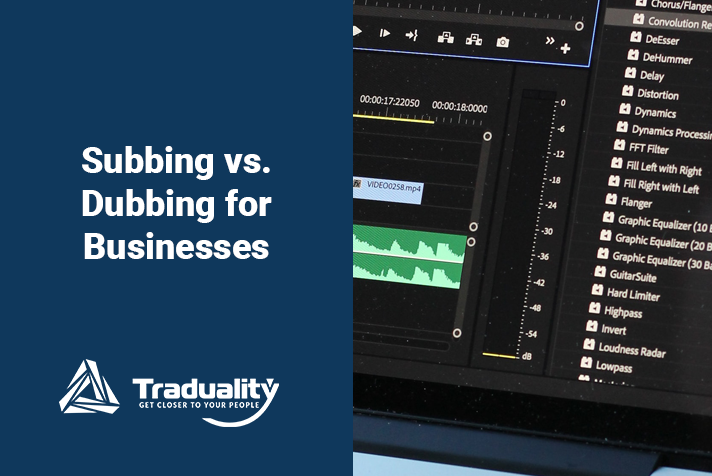Preparing onboarding materials and training videos for a multilingual workplace takes a little extra time and effort. Still, it pays off in the long run by enhancing your employee’s experience with job training and accessibility. When it comes to translating video content, however, there are two ways of doing so: subtitling the videos or dubbing over the original audio.
Both methods are great for creating a friendly, multilingual work environment, but which should you choose for your content?
Use this guide to determine if subs or dubs are right for you:
What are Subs, and What are Dubs?
Before getting into the fine details of the “subs vs. dubs” debate, let’s understand what they are first.
Subtitles are words added to the bottom of a video that allows viewers to read what the characters are saying. Subtitles are often taken directly from a video transcript, a standard script, or a localized translation. They are often used in movies and television for international audiences but are also essential tools for deaf and hard-of-hearing people and people with audio-processing disorders.
The process of adding subtitles to a video is called subtitling. It’s a post-production process that allows viewers to select their preferred subtitles directly from the video player. Subtitles explicitly designed for deaf and hard-of-hearing people are called closed captions. Closed captions feature extra audio cues in parentheses to help provide context to the viewer.
Dubbed videos feature paid actors voicing over characters in the translation’s target language. Like subtitles, dubbed content comes from a professionally translated script, which voice actors use for their work. You’ll find dubs most commonly in popular animated films and television that were localized for international release.
Dubbing is a post-production process that fundamentally changes the video being dubbed over. A dubbing team must record and insert voice work and synchronize mouth movements to make the dub feel realistic.
The Pros and Cons
So, what are the pros and cons of subtitles and dubbed videos? Generally speaking, subtitles are the least expensive option, but dubs provide viewers with a high-quality training experience that feels much more personal.
Cost
Subtitles are significantly less expensive than dubbed videos. All the translation team needs is a translated script and software to format the subtitles into the video. Dubbing, however, requires voice actors, recording software, and audio editing software alongside a translated script.
Production Time
Because subtitles only require a translated script, they take less time to produce than a dubbed training video.
Dubbing employee training materials takes significantly longer because the translation team has to cast and prepare voice actors, book time in recording studios, and edit a video’s audio and visual components to fit the dub. Dubbed scripts may also differ from subbed ones to better match an actor’s lip movements.
Audio Quality
Audio quality tends to vary from production to production. If your original training video has audio that may be difficult for viewers to understand, you’ll need subtitles regardless of whether or not you want to dub it.
With dubbed content, controlling audio quality for training videos is a bit easier, as voice actors record their lines separately in a studio. Then, editors can adjust the actor’s volume levels if something is too loud or quiet.
Accessibility
Subtitles are a fantastic accessibility tool and are recommended for most training videos. Employees with difficulty hearing, processing audio, or understanding thick accents will benefit from subtitles in their native language.
Dubbed videos, however, are far more accessible for people who do not speak the content’s source language. They may also help your employees feel more comfortable in the workplace, knowing that there is content specifically catered to their language needs.
Educational Use (Outside of Work)
Subtitles are excellent for people learning new languages because they preserve the original audio of your video content. Bilingual employees or employees learning your source language may benefit from subtitles as a general translation, while the audio acts as a guide for pronunciation and diction.
Educational Use (On the Job)
If your content requires employees to pay heavy attention to the video’s visuals, it’s best to dub them over as well, as subtitles will detract from the video’s primary purpose. Training videos that teach employees how to use heavy machinery, perform life-saving tasks, or tasks that require fine technical skills will benefit from getting dubbed over rather than subtitled.
Which Should I Use?
When choosing whether to subtitle or dub your employee training videos, the first thing you should keep in mind is your budget: smaller businesses may have a more challenging time funding dubbed content and may want to go with just subtitles. Larger businesses, on the other hand, may request dubbed content only without subtitles.
Regardless of what you choose, make sure to prioritize accessibility before all else. Generally speaking, subtitles are more accessible to audiences than dubbed content, so if you’re unsure what to do, consider starting with subtitles.
Your Subs or Dubs Checklist
When choosing whether or not to subtitle or dub over your employee training videos, there are a few key points to consider before consulting your professional translators. We recommend asking yourself these questions:
- What is my budget for video translation?
- How many different language translations do I need for this content?
- Do the videos require extensive visual engagement?
- Are my employees bilingual, or do some only speak one language?
- Is the audio for all videos clear and easy to understand in the source language?
Ready to get started on your next translation project? Traduality has everything you need to succeed; create your first project today and find vetted translators, or book a meeting with us to learn more about your specific needs.
Updated 2/21/2024.





0 Comments